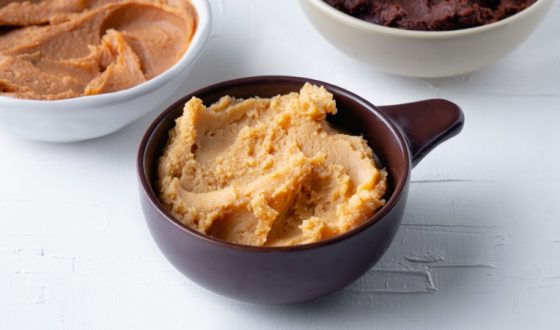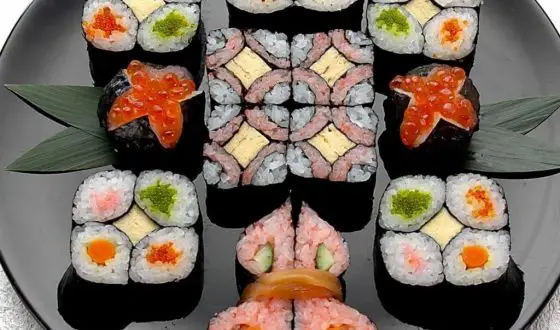What Is Tempura – A Guide To Japanese Traditional Cuisine
Touted as one of the most common and traditional Japanese dishes, Tempura is definitely what you shouldn’t miss when traveling in Japan. Even when you’re not a big fan of Japanese food, you’d be surprised by not only its eye-catching appearance but also the taste buds. So what is tempura, how to make and eat it? Let’s find out all about it in this location guide.
What is tempura and how to make it?
What does tempura mean?
Tempura (天ぷら/天麩羅) is a uniquely crispy, non-greasy Japanese dish, consisting of seafood and vegetables that have been battered and deep fried. The name “tempura” originates from the Latin phrase “quattuor anni tempora”, which means no meat is consumed. In spite of having been eaten in Japan for ages, not many people know that tempura was rooted back to the 16th century when Portuguese missionaries first introduced to Japan the concept of fritter-cooking with a batter of flour and eggs.
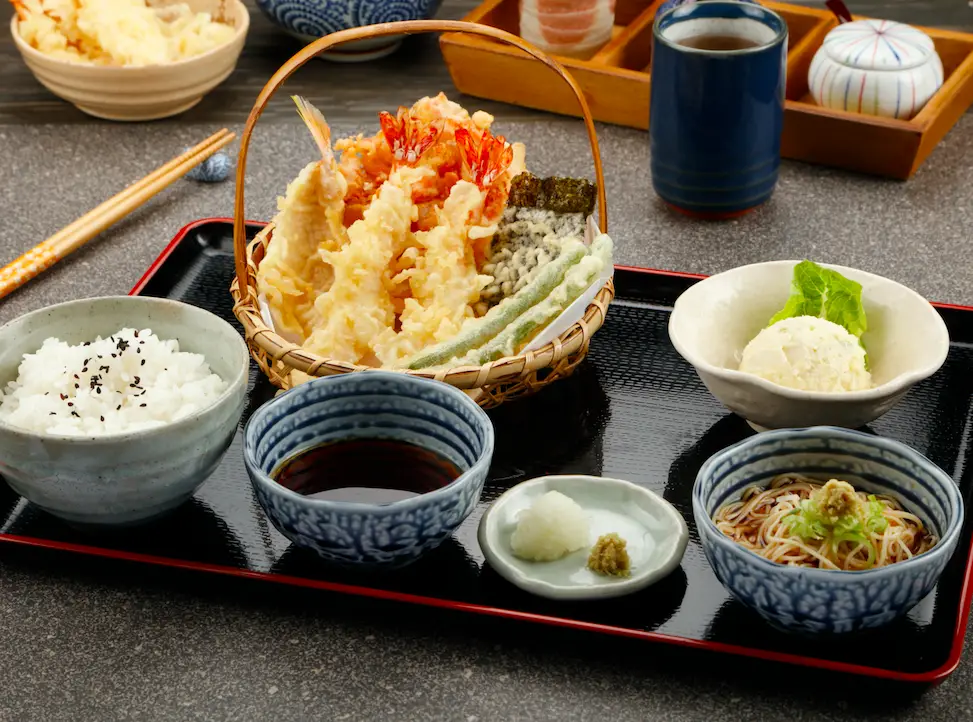
That the batter uses no breadcrumbs creates the signature crispiness and lightness that tempura is so well-known for
SEE MORE:
Tempura was initially served as a luxury meal in wealth families during the observance of Lent. Since Edo period, it gradually became common due to the decreasing of cooking costs and the abundant seafood in Tokyo Bay. Edo is also the place that invented the dipping sauce for this traditional dish.
Tempura types
Japanese tempura comes into many types, using different ingredients and condiments. For example, in Kansai style, the main ingredient is battered vegetable, fried in neutral oil and usually served with salt – ether plain sea salt or aromatic salts flavored with matcha, sansho pepper, or nori seaweed. While in Kanto, people use both seafood and vegetables to cook. Main ingredients are deep fried in sesame oil until they have the typical golden color, then served with tentsuyu – a dipping sauce made from dashi broth, mirin, and soy sauce. Besides, tempura served with grated daikon radish and ponzu, a citrus and soy-based sauce is called Oroshi style.
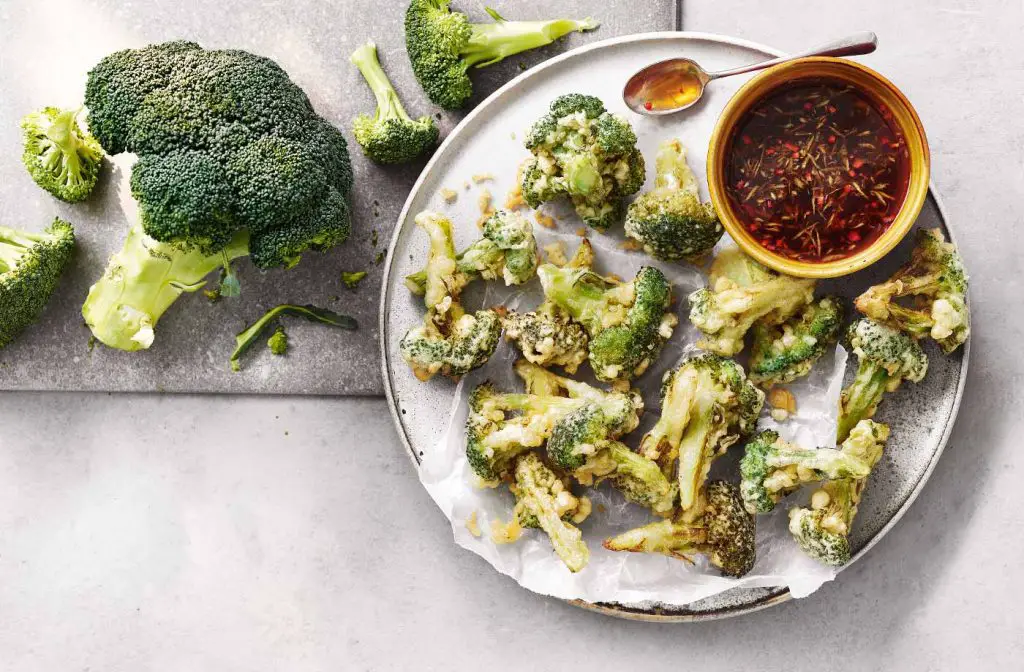
Broccoli tempura accompanies with pepper sauce
Today, tempura can be enjoyed in various styles, from seafood and meat to vegetables, flowers, fruits, and even desserts like ice cream and gummy candies. You can easily find it in casual chain restaurants, supermarket bento lunches, noodle shops, or even in Japan’s traditional haute cuisine, kaiseki dining. There are also ‘tempuraya’ restaurants that specialize in tempura. Depending on the restaurant, food is either made with sesame oil, cottonseed oil, or the restaurant’s original oil recipe.

Ice-scream coated with deep-fried tempura is a fancy dessert
What is tempura made of
Basically, tempura is made of seafoods and vegetables wrapped in batter.
Base ingredients for batter include the following:
- Eggs
- Flour
- Cold water
- Oil (vegetable, canola or sesame oil)
Moreover, soda water, baking soda, cornstarch or potato starch could also be added up to the recipe to increase the crisp texture.
Main ingredients
An endless array of seafood and vegetables can be used as the main ingredients of tempura.
| Seafood | Vegetables |
| shrimp, squid, scallop, crab, ayu (sweetfish), anago (conger eel), fish, catfish, white fish, cod, haddock, pollock, coley, plaice, skate, ray, rock salmon, whiting, sea bass, sea perch | bamboo shoots, bell pepper, broccoli, butternut squash, carrot, eggplant, gobo (burdock, Arctium lappa), green beans, kabocha, mushrooms, okra, onion, pumpkin, potato, renkon (lotus root), seaweed, sweet, potato, yam |
Beyond these traditional ingredients, the recipe can be modified with local seasonings or special items that contribute to the flavor, such as ice cream, chicken, soft boiled egg or Japanese maple leaves. Sometimes you’ll see types of nuts and herbs like gingko nut, chestnut, and myoga ginger put in to the mixture, as well as premium ingredients like uni (sea urchin) wrapped in shiso (perilla herb) leaf. Tempura is commonly served with tentsuyu, a rich dipping sauce made from soy sauce, mirin, and dashi.
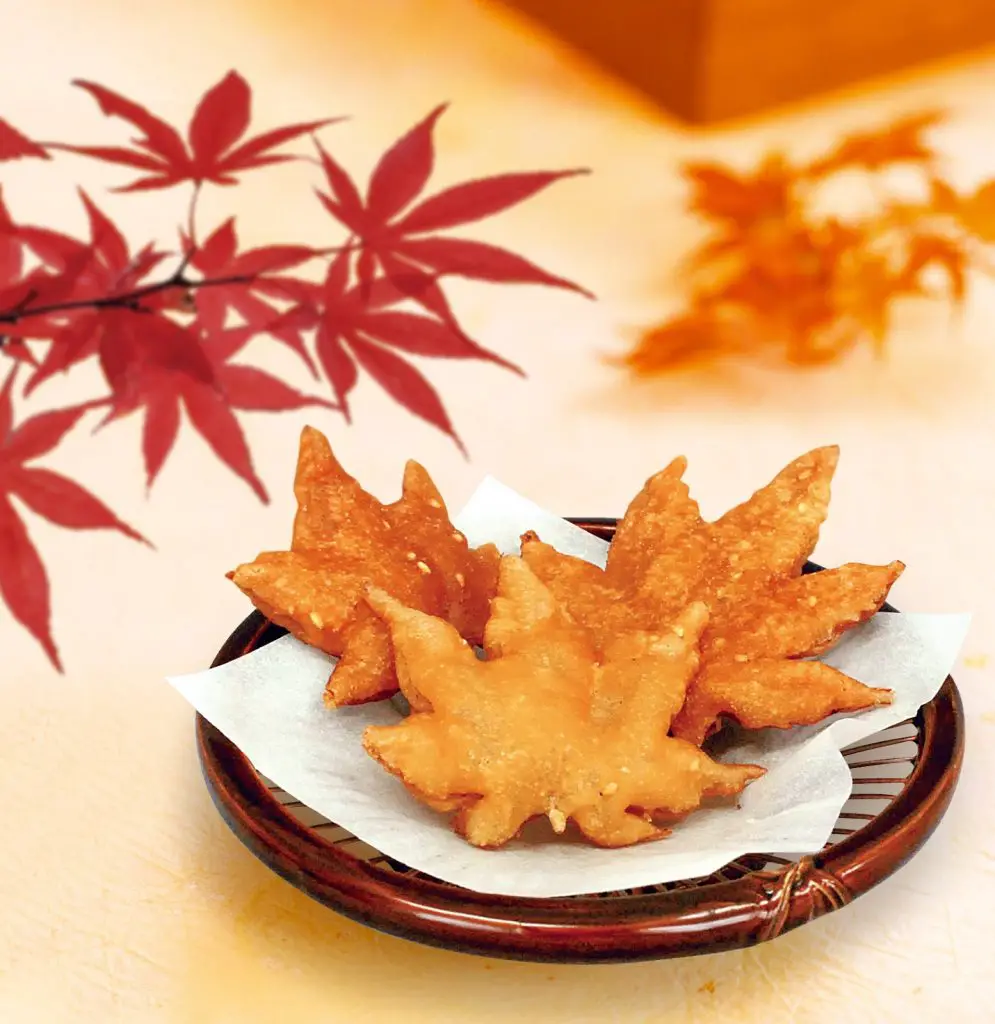
Locally famous ingredients can be found in some regions
How to make tempura
Believe me, the steps to create tempura is relatively simple and you can make crispy and delicious homemade tempura by following this recipe and tips!
Preparation:
– Favorite types of vegetables, meats and seafood
– Oil (vegetable oil or canola oil are most common)
– Batter:
- 1 cup soft wheat flour (cake, pastry or all-purpose flour)
- 1-2 eggs
- 2 cups iced water
– Dipping sauce (tentsuyu)
- 1 cup dashi stock (Japanese cooking stock made from fish or seaweed)
- 1/3 cup mirin (Japanese sweet rice wine)
- 1/3 cup soy sauce
Now you’re ready to start!
Make the batter
- Sift flour once or twice to make it lighter
- Have vegetables/ meats/ seafood cleaned under water and chopped into slices or strips
- Mix flour, salt, eggs, and cold water together by chopsticks in a few seconds
- Dip prepared vegetables/ meats/ seafood in the batter for around 10 mins
Fry
Have the batter briefly deep-fried in hot oil and wait till it turns into crispy tempura flakes (normally 1-2mins for vegetables and meats, 30s for seafood). Ideal temperature of oil is 160°C-180°C (320-356°F).
Make the sauce
Put every ingredients for sauce into a pan and have them stirred with low heat.
Note:
- Batter is freshly mixed in only a few seconds, leaving lumps in the mixture that to give the batter a crisp texture when fried. Overmixing will make batter heavy, unfairly, and un-crispy.
- Batter must be kept in cold water by adding ice, or by placing the bowl inside a larger bowl with ice in it.
- Scoop out the bits of batter (known as tenkasu) between batches of tempura, so they do not burn and leave a bad flavor in the oil.
- Different types of oil have different effects on food’s color. For example, Kansai people prefer neutral oils such as vegetable oil and cottonseed oil that give the tempura a blond color when fried, while the Kanto area favors sesame oil that gives food a more golden color.
How to eat tempura
Although tempura first featured as a street food, nowadays, it can also be served as its own meal, appetizer or a side dish.
Teishoku meal
The traditional way of eating is teishoku meal in which the main tempura entree is accompanied by a bowl of rice, miso soup, grated daikon, and other small side dishes. Sauce could be tentsuyu or salt. Sometimes, mixtures of powdered green tea and salt or yuzu and salt are also used.

Teishoku dinner set, a combination of seafoods and vegetables with steamed rice, Miso soup and dipping sauce
Tempura soba/udon
Found in most of soba and udon restaurants, tempura features as an excellent topping for Japanese noodles. The noodles can be served either hot in broth or chilled on a traditional bamboo basket with noodle dipping sauce.
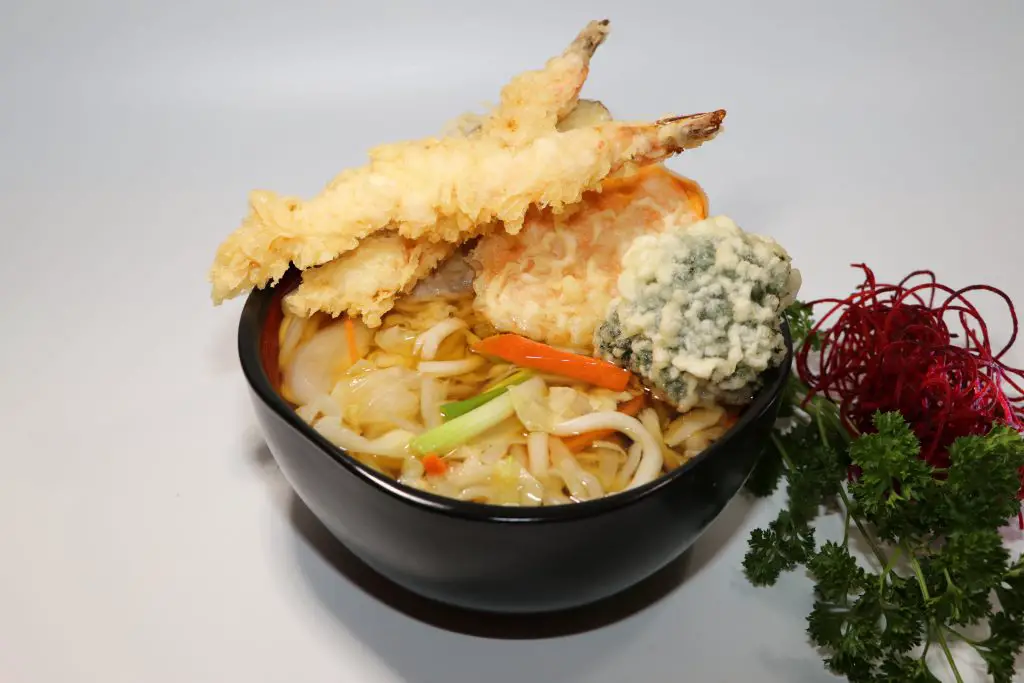
Tempura is an excellent topping for Udon partly because of how the crispy tempura batter blends in with the flavor of the soup broth
Tendon
Another popular dish is tendon (tempura donburi). Tempura is served on steamed rice in a bowl with a sweet soy sauce already drizzled over it. Tendon restaurants with reasonable prices can be easily found in Japan.

It’s a great dish to enjoy the perfect combination of crispy seafood, rice and sweet soya sauce
Sushi roll
Last one is sushi rolls with tempura inside, not a very popular dish in Japan but in other countries like US and Korea. You may see the rolls themselves are deep fried in some restaurants.

The crunchy shrimp slices and panko crust gives this sushi roll added texture, making it perfect for every occasion
Besides, many modern Japanese restaurants offer tempura as a light snack in between main courses.
Frequently asked questions
What is the differences between Ebi Furai and Tempura
Basically, it is the coating that makes the difference between these two dishes. Ebi furai is dusted with flour, dipped into a beaten egg mixture, then finally coated in breadcrumbs and deep-fried to form a crunchy, golden brown shell. The other one, whereas, is a light batter mixed from cold water, flour and ingredients. Tempura coating comes in a relatively thinner than that of ebi furai. Their sauce and condiments are also different.
Is Tempura Vegan and/or Vegetarian-Friendly?
What’s said, tempura can be suited to meet the needs of discerning eaters as both the batter and food items could be switched out to serve vegetarian and vegan lifestyles or preferences. The batter can be made either with eggs which provides a fluffier coating or without eggs which gives the vegetables a crispier texture.
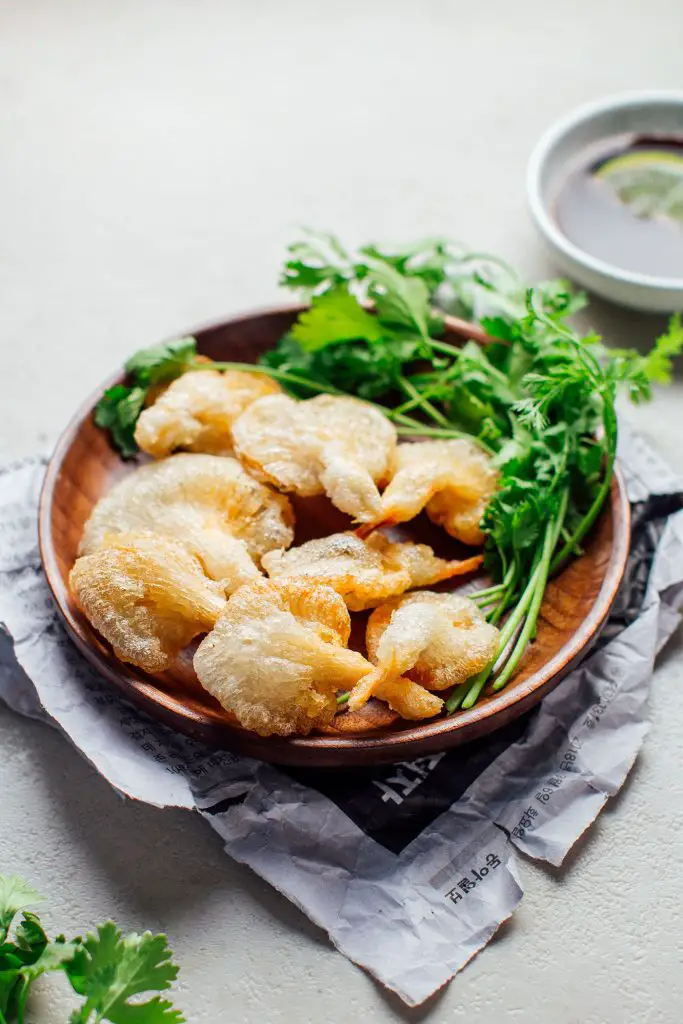
Although tempura is famous for use with lean meats and seafood, both its batter and food item that is coated could as easily be vegan-friendly
How do you keep tempura crispy?
To keep it from getting soggy, it’s advisable to reheat the dish in the (toaster) oven. Let it drain and cool completely before using. You can close the bento box only after all the food is cooled so that there will be no condensation formed inside the bento box.
Conclusion
Tempura, a perfectly deep fried Japanese dish, is absolutely tasty and addicting. It could be an excellent home-cooked meal or a fancy food enjoyed in chain restaurants. Hope you’ve got some awesome ideas about what is tempura and how to enjoy it after reading this blog. When you find yourself in Japan, don’t forget to give it a shot!



